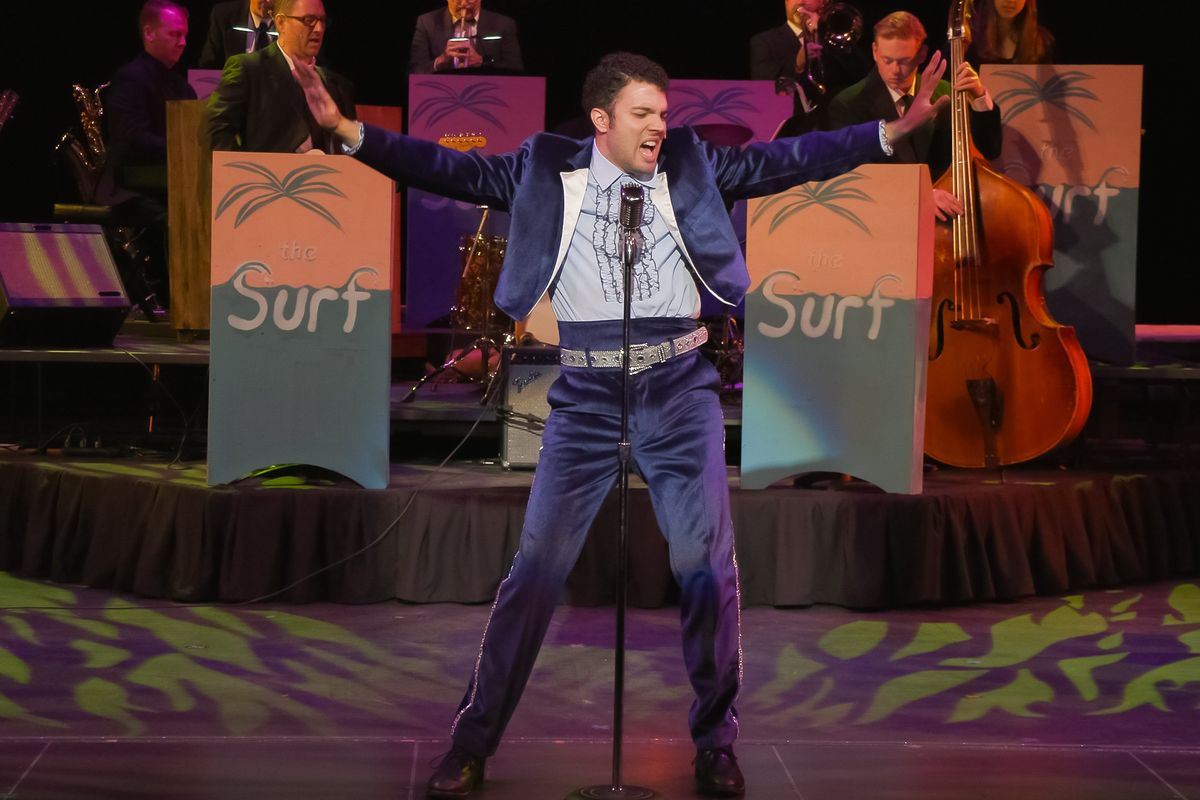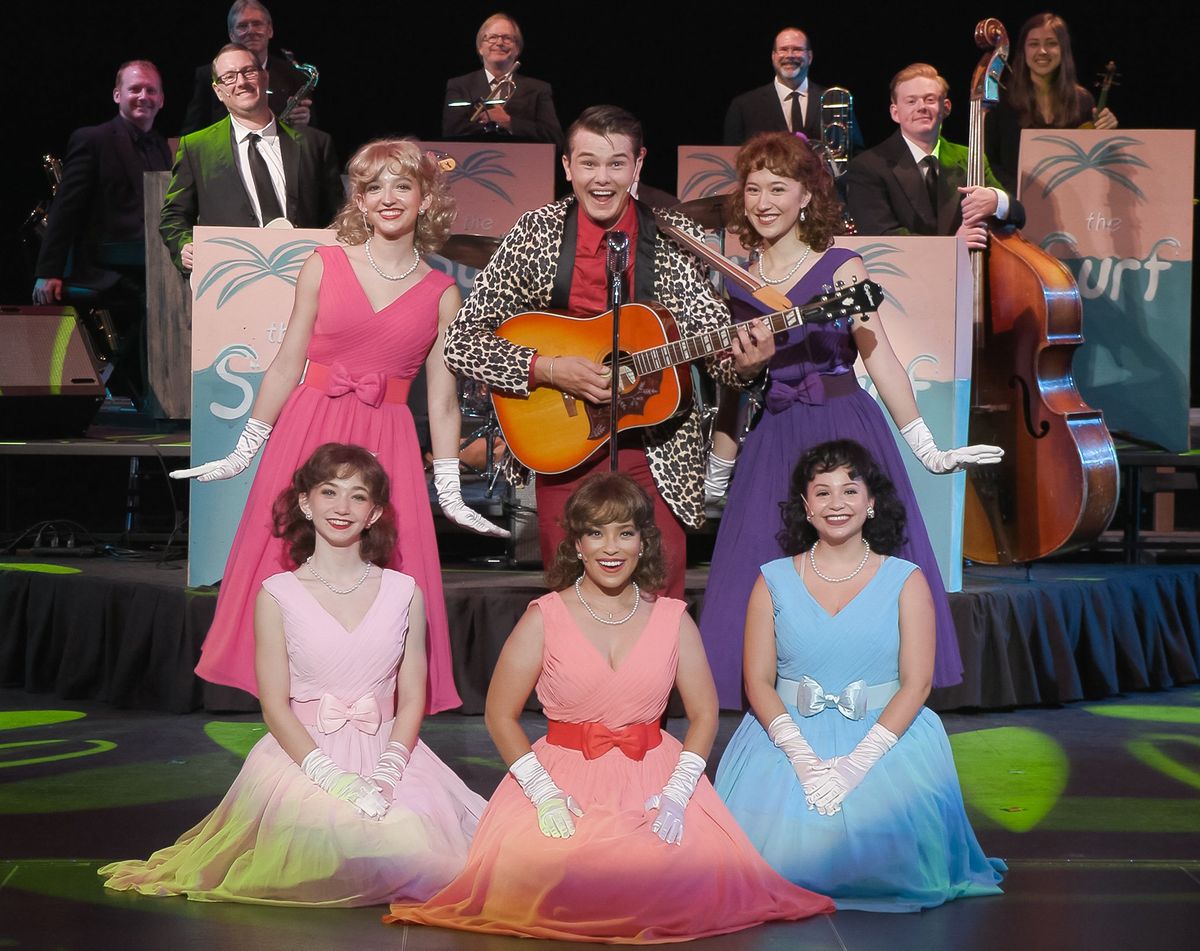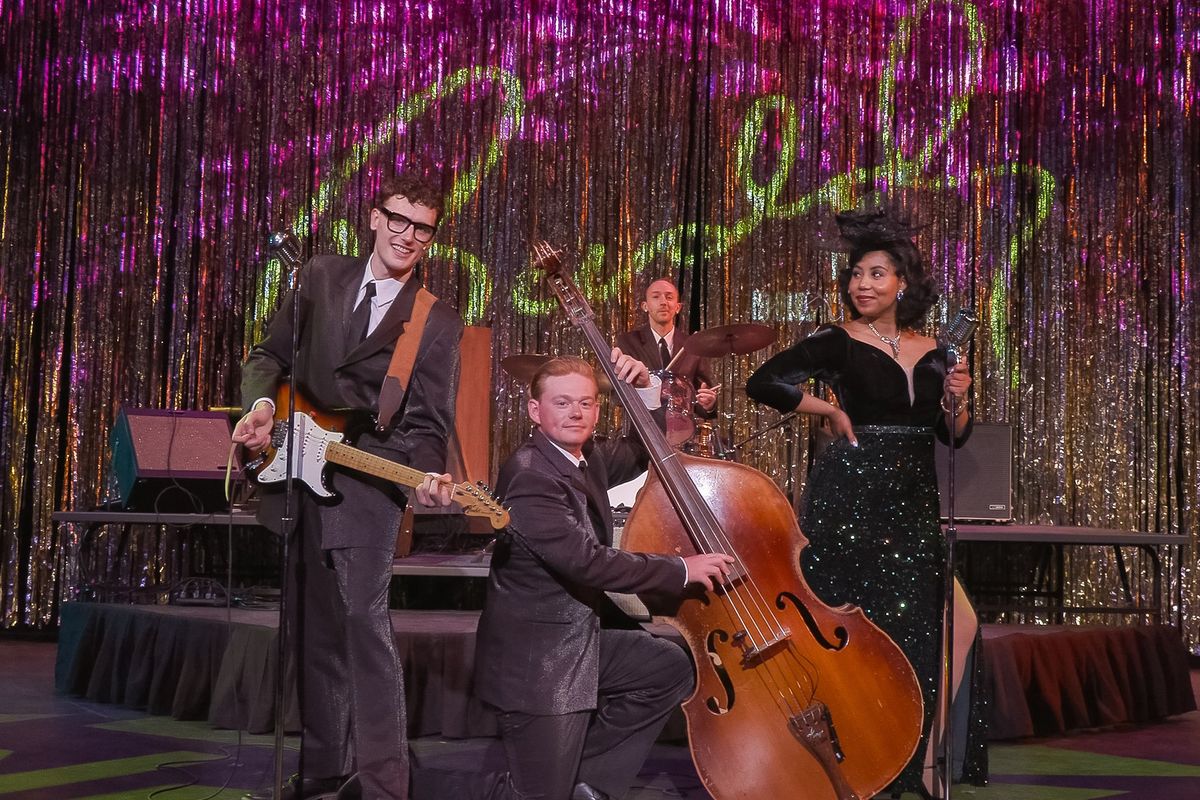In a nod to the past, Spokane Valley Summer Theatre makes return to its first production ‘Buddy: The Buddy Holly Story’
Buddy Holly, at left, played by Gunnar Rorholm, performs at the Apollo, as part of Spokane Valley Summer Theatre’s production of “Buddy: The Buddy Holly Story.” (Courtesy of Melody Chang)
Spokane Valley Summer Theatre’s production of “Buddy: The Buddy Holly Story” marks two important milestones, one somber, one celebratory.
It was 65 years ago this year that singers Buddy Holly, Ritchie Valens and J.P. Richardson, aka the Big Bopper, along with pilot Roger Peterson, died in a plane crash on Feb. 3, 1959, dubbed the “Day the Music Died” by singer Don McLean in his song “American Pie.”
The jukebox musical also marks a return to the first show produced in 2016 by Spokane Valley Summer Theatre after its opening.
Both elements weighed on director Collin Pittman’s mind when asked to lead this production but he didn’t need any convincing to direct the show. In yet another celebratory connection, directing this production of “Buddy” is Pittmann’s capstone thesis project as he finishes a master’s of fine arts in theater directing at East 15 Acting School through the University of Essex.
“Our older patrons will be really familiar with the story, but we’re introducing this show and the story and the music of Buddy to a whole new generation who are seeing it for the first time, so that’s very exciting,” he said.
“Buddy: The Buddy Holly Story,” written by Alan Janes, opens Friday, July 26, and runs through Aug. 11 at Central Valley High School.
The musical begins in January 1956, when local radio DJ Hipockets Duncan (Paul Villabrille) encourages Holly (Gunnar Rorholm) to start a band. Buddy Holly and the Crickets, as the band is called, begin to make a name for themselves, even signing with Decca Records in Nashville.
After a bumpy start at Decca, the group signs with producer Norman Petty (Dan Griffith). It’s with Petty that Holly and the Crickets record “That’ll Be the Day,” which quickly tops the charts. Holly and the Crickets are fan favorites and soon hit the road on a tour that takes them to New York’s famed Apollo Theater.
After a marriage to Maria Elena Santiago (Isabella Mesenbrink) and a breakup with the Crickets, Holly embarks on a solo career, eventually joining the Winter Dance Party bus tour alongside Valens (Ilan Hernandez) and the Big Bopper (Dylan James). “Buddy: The Buddy Holly Story” ends the day of the plane crash in Iowa.
The musical also stars Owen Larson (playing Joe P. Maudlin), Taylor Belote (Jerry Allison), Art Corcoran (Tommy Allsup), Ryan Patterson (Vi Petty), Vanessa Cole (Marlena Madison), Zane Bresko (Jack Daw/WWOL DJ), Charles Fletcher (Murray Deutch/Hayrider) and Skyler Kelley (DECCA Producer/Clearlake MC). Mesenbrink, Noelle Fries, Ruby Krajic, Anna Maria Seiple and Ashlynn Williams play the Snowbirds.
Music director David Brewster conducts the band as well as plays keyboards. The band also features Larson (bass), Belote (drums), Corcoran (guitar), Andy Plamondon (trumpet), Craig Catlett (tenor saxophone), Chris Poole (trombone) and Brooke Bos (violin).
The musical features beloved tunes from Holly and others including “Peggy Sue,” “La Bamba,” “Chantilly Lace” and “Johnny B. Goode.”
Pittmann, who is also director of education at Spokane Valley Summer Theatre, cast lead performers who are at or around the same age Holly, Valens and Richardson were when they passed away, partially with intention and partially because of the amount of young talent available for the show.
“It’s been exciting for me as a young director to be able to work with that really young, vibrant, exciting energy on a show that really celebrates that sense of drive and that sense of passion for music,” he said.
Pittmann remembers Rorholm’s audition in particular because of the charisma and energy he brought into the room. That Rorholm looks a lot like Holly, Pittmann said, was the cherry on top.
Rorholm also caught Pittmann’s eye because he knew how to play guitar, something Rorholm only picked up after graduating college in December. What started as a fun way to spend time became a nerve-wracking challenge once he got the part of Holly, but Rorholm quickly found his groove.
“It was the voice in my head that said ‘You’re about to play Buddy Holly, and you’ve got to learn all of this music in a couple of months. You’re not going to make it,’ ” he said. “But the minute I turned that off, I was like, ‘You know what? It’s rock and roll. It’s all for fun.’ At the end of the day, I’m going to have amazing musicians on stage with me who are going to be backing me up.”
Rorholm also said he has guitar teachers Joe Brasch and Mellad Abeid to thank for getting him stage-ready.
Along with learning guitar, Rorholm also looked into Holly’s life before his audition. He was particularly drawn to a documentary featuring Dion DiMucci of Dion and the Belmonts, a band that performed on the Winter Dance Party tour.
“It was one of those moments where I was like, ‘God, he really is just a normal person,’ ” Rorholm said. “Behind all of this ‘I look just like Buddy Holly,’ the Weezer riff, behind the plane crash, behind ‘American Pie,’ there’s this 22-year-old kid. That passion for music and passion for entertaining his friends and his generation and singing the music that everybody wants to hear and saying the things that people want to hear and dance to. It was really eye-opening.”
Pittmann, of course, talked about Holly’s life and career with the cast, but he also spoke about the culture of 1950s America, from the highs of new music and technology to the lows of pre-Civil Rights Act racism. Illustrating that point, the set will feature the American and Confederate flags at the beginning of the show.
“(It’s to) really capture the stakes of the era and what was going on and the severity of that, but also to contrast it with Buddy’s personal beliefs,” Pittmann said. “He really was so progressive in terms of his pushing the boundaries of music and getting inspiration from so many Black artists in his musicianship and performing with them and touring with them. He really shattered the glass ceiling in that respect, which is quite exciting. What a figure to celebrate.”
Pittmann and Rorholm agree it’s easy to celebrate Holly years after his death, thanks to his musical innovations and personal beliefs that went against the status quo. He led the way for rock and rollers like the Beatles and the Rolling Stones and, Pittmann believes, could have been more musically successful than Elvis Presley based on the trajectory he was on.
“He was on the cusp and on the forefront of so much change, and that still impacts the way in which music is produced and the sound that we hear today, whether people realize that or not,” Pittmann said. “It is so important to highlight his life and his story and his music for that very reason.”


